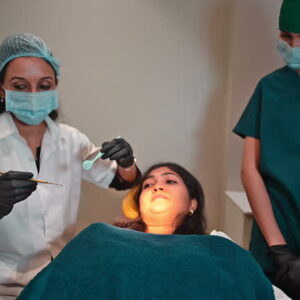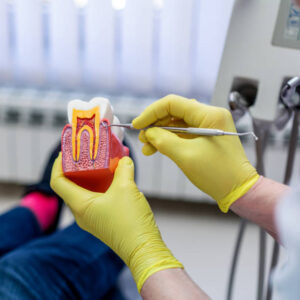An error was made.
No matter whether you practice in Baghdad or Los Angeles, you need to know why so that you can fix it.
Root cause analysis is an analytical method that seeks to identify the root causes for a problem, which in turn helps to identify potential solutions. It’s one of the best tools in dentistry for preventing errors from happening again.
Other than fault identification, it can also be used to determine why every process is working fine and what needs to be tweaked to make them perform even better.

Dr. Al Sammarraie
RCA involves five steps:
- Identify the problem.
- Gather information about the problem.
- Make an assessment of the problem.
- Determine possible causes of the problem.
- Develop solutions for preventing recurrence of similar problems in the future.
All RCA methods require you to define the scope of your investigation, which means identifying all possible causes within the workplace that could lead to this result. You can use the following tools when implementing RCA in your workplace.
The 5 Whys
The technique involves asking “Why?” five times in succession to determine the root cause of a problem.
For example, while I was doing my residency, the dental department canceled appointments of patients who tested positive for infectious diseases such as hepatitis B until they recovered.
The problem happened when the dental department moved from a dry heat system into autoclaves, and the technicians were used to sterilizing everything after hours. The dental clinic relied on multiple sources of electricity.
A changeover from one vendor to the other happened at night, during which one would go off for about 5 minutes before another one picked up. When that happened, the autoclaves failed to restart to continue sterilization. The power issue was solved, and the autoclaves were running, but, first of all, let’s apply the five whys to that situation and see what was happening.
- Why were the appointments canceled?
Because the staff was not sure if the dental equipment was fully sterilized before being used by another patient
- Why were they not sure?
They were not using pouches, chemical detectors or any measures that could ascertain proper equipment sterilization.
- Why were they not using quality assurance measures?
They did not have the necessary infection control training.
- Why did they lack proper training?
The infection control department at the time was ineffective in performing its duties.
- Why was the department not working effectively?
They did not have clear guidelines, protocols and internal audits for quality assurance.
From this analysis, the root cause of the problem can be identified, which can set an action plan to develop recommendations on technology management and manufacturing to have all equipment work effectively.
Fishbone diagram
A fishbone diagram is a type of flowchart that helps you identify the root cause(s) of a problem.
It’s called “fishbone” because it looks like the bones in a fish, with a main backbone and smaller subordinate bones branching off. It may be used as a form of brainstorming technique to help identify all possible causes for an observed effect or symptom.
A typical example would be patients in a dental clinic complaining about long waiting times during their appointments. Typical reasons could be that the staff was taking very long to process patients, or that the dental clinic was short-staffed, or the dental appointments were not well-planned, or even that the instruments are few and some need sterilization before being used by again, which takes a while. All these possible reasons forms part of the subordinate bones of the fishbone.
Fault tree analysis
A fault tree analysis is a structured method for determining the possible causes of a particular undesirable event and can be useful in the profession.
A fault tree analysis starts with an undesirable event. Each possible cause of this undesired outcome is called a failure mode.
A failure mode can be any event that is not an undesired outcome, and each failure mode has its own set of contributing factors or causes. Each of these contributing factors may itself have additional contributing factors and so on, down to simple last-resort events such as insufficient skill or knowledge.
Root cause analyses and actions (RCA2)
RCA2 is a root cause analysis tool that can help health care organizations reduce costs, mitigate risk and prevent patient harm. RCA2 provides a structured approach when conducting an investigation into an adverse event or near-miss event that has occurred. It gives you the tools needed to gather evidence from multiple sources (e.g., medical records, incident reports) in order to identify what happened during an adverse event or near-miss event and why it happened.
Failure mode and effects analysis
Failure mode and effects analysis is used in many sectors, including health care, to determine when there are potential issues with products or processes that could lead to failures. By identifying the potential causes for these issues, dentists can work on eliminating them before they become problems.
An example is multiple members of staff being stressed out and not being 100% productive in the dental clinic. They may decide to resign from work. A possible reason could be that the staff is underpaid yet the workload is immense, or the financial effect of the COVID-19 pandemic is taking a toll on them. The problem is then identified and addressed before it could have it has a catastrophic effect on clinic operations.
How to maximize root cause analysis
The best way to maximize your ROI from root cause analysis is to implement it as a standard part of your quality management system, not simply as an ad hoc solution to a problem or defect. This means that you need to develop and implement processes and procedures for root cause analysis, including how often it should be performed, who should perform it, who should be involved in the analysis, what tools will be used (including data collection tools), how data will be analyzed and by whom.
Muhalab Al Sammarraie, D.D.S., grew up in Baghdad before coming to the U.S. as a foreign-trained dentist. He graduated with honors in 2019 and became a member of the ADA, California Dental Association and the San Diego County Dental Society. While working towards his second degree, he accrued leadership experience in public, private, and nonprofit sectors through leading teams and overseeing process improvement in education, social service and health care. Dr. Al Sammarraie is currently a site dental director at AltaMed Health Services, one of the nation’s largest FQHCs. He is also a subject matter expert for the dental board of California. Outside of dentistry, Dr. Al Sammarraie supports activist groups in Iraq that help war victims and displaced people find education and medical care.





